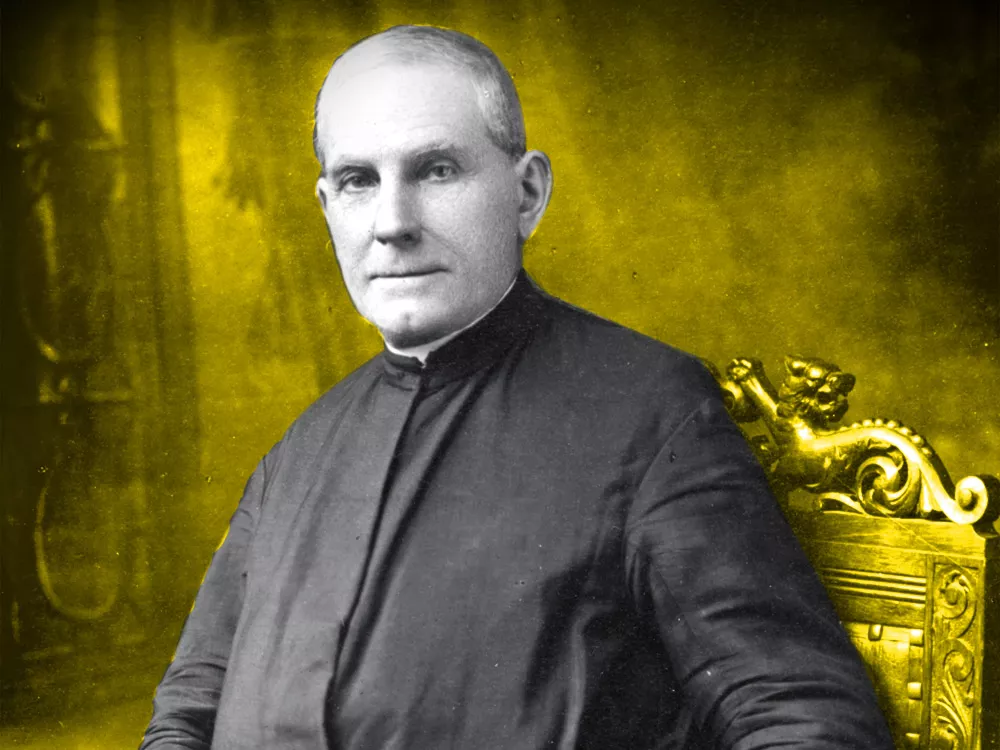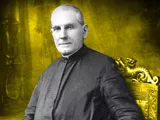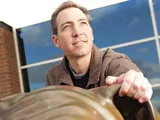Father Cataldo and the Jesuit history of Spokane
Gonzaga Prep alum Vincent Felice crafts a statute for his alma mater
“I jumped,” recalled Father Joseph Mary Cataldo, when he heard a knock on his bedroom door one fateful evening in January of 1885. “I jumped, and that jump saved the Rocky Mountain Mission.”
Against his better judgment, Cataldo was in Fiesole, Italy — far from the many, many obligations pressing for his time back in the fledgling settlement of Spokane. But two regional bishops had insisted that he travel to Italy and appeal both to the Father General of the Society of Jesus — leader of the Jesuit order — and to the Pope, himself, for increased support of the Catholic community in the Inland Northwest.
Dutifully, Cataldo had taken a steamer from New York to Antwerp, Belgium, in the fall of 1884. But soon, as he had feared, his visit teetered on becoming a complete waste of time. To begin with, the Jesuit curia, or Society headquarters, was temporarily in exile from Rome and had relocated to Fiesole. Then, when Cataldo reached Tuscany, he found the Father General so ill that a substitute, a Vicar General, was making decisions in his stead.
It was from this Vicar General that Cataldo learned the Society would provide no additional resources — neither men nor money — for the remote corner of the globe they called the Rocky Mountain Mission. Society finances simply could not meet such a request. Finally, when Cataldo traveled to Rome for an audience with Pope Leo XIII, he received similar negative news.
Despair grew even deeper for Cataldo after a cablegram from America arrived at the Society’s villa. The message was intended for Cataldo, but, as he recalled, “my name was not spelled well,” and so the missive found its way onto the desk of the Vicar General. After reading the sad message, and realizing for whom it was intended, the Vicar General personally delivered it to Cataldo in his room.
Thus the knock at his door that echoes across the region to this day.
The Call of the West
The clipped phrases of the cablegram announced that Father Louis-Marie Ruellan, Cataldo’s Vice-Superior for the Rocky Mountain Province, had died of pneumonia in Spokane. It was a crushing blow because Cataldo had placed Ruellan in charge of his many plans for Spokane for the duration of his trip to Italy. Ruellan’s assignments included the construction of Spokane College, the building of a church for Saint Aloysius Parish and another church to be dedicated to Our Lady of Lourdes, with yet a fourth project taking place at Saint Michael’s Indian Mission near Bigelow Gulch.
Suddenly, every prospect for Spokane appeared doomed.
But the Vicar General took an interest in the drama unfolding so far away and became so distressed at the genuine sadness of the priest from Spokane that, according to Cataldo’s memoirs, he undertook an impetuous action without consulting others. The Vicar “went to his room and wrote for me a letter, to all the Provincials of the Society, in which he said all he could, except ordering them … to help, each one as he could, the Missions of the Rocky Mountains.”
With this special passport to enter European and American Jesuit schools, Cataldo could recruit students to join the Rocky Mountain Mission, or the Catholic community in Spokane, or the college being built in Spokane.
The foundation of modern Spokane was sealed as the Vicar General wrote that letter.
Writing to a confidant, Cataldo confessed that as much as Ruellan had worked diligently for the Society in Spokane — “a hero among heroes,” he anointed him — “he will be of much greater use to us in heaven than he would have been had he stayed with us here below.”
Using the Vicar’s letter as his entrée, Cataldo prowled Western Europe deep into the year of 1885; then he transferred his energies to visiting seminaries across the Eastern United States. Cataldo approximated in his notes the number of priestly recruits he gathered in Europe and America at 31, but he chose not to count the Jesuit brothers, which would boost the tally to probably 50 men.
The Vicar General’s call to service had turned the tide for the Rocky Mountain Mission and Spokane. Six of his recruits became future presidents of Gonzaga College, — seven if you count Father John McHugh, who is considered a “second-generation volunteer,” meaning he came to the Pacific Northwest after hearing about Cataldo’s recruitment efforts from another person.
Indeed, Cataldo’s jump at the knock on that door in Fiesole saved four decades of hard work by the Jesuits in the Inland Northwest and paved the way for the Society’s future success in Spokane.
Serving the Oppressed
Cataldo brought considerable experience to the job of Superior of the Rocky Mountain Mission when the Father General appointed him in 1877. Forty years old, a Sicilian by birth, Cataldo had entered the Society of Jesus at the age of 15. He began his studies in Italy and Belgium and completed them at Santa Clara College in California, where he interacted with veteran Jesuit missionaries, including Father Gregory Mengarini, a colleague of Father Peter De Smet, the initiator of Jesuit presence in the Pacific Northwest. In 1865, Cataldo volunteered for the Rocky Mountain Missions.
After his arrival in the Pacific Northwest, Cataldo lived among several tribes. He became an accomplished linguist, eventually mastering more than a dozen Native American languages. Cataldo became so involved with Indian affairs that he was, at one point in 1877, accused by a federal Indian agent of being an accomplice to Chief Joseph in the Nez Perce War.
As the Superior of the Rocky Mountain Missions from 1877 to 1893, Father Cataldo exhibited a single-minded and unreserved dedication to Native Americans. It disturbed him to see the Indian’s casual commitment to Christianity. Their once legendary zeal for the Jesuit message began to diminish with the influx of gold seekers into the Pacific Northwest; their disinterest accelerated during armed conflicts over reservation lands, and it reached its lowest point after the arrival of permanent settlers to the region.
Consequently, progress by the missionaries in such areas as gambling, superstition, polygamy and revenge slowed. Training the tribesmen in agriculture and animal husbandry was essential, but not sufficient by itself to withstand the destructive influence of whites. Clearly, Cataldo found, the Jesuits would have to modify the conduct of the pioneers as well as the Indians. “If we do not attend to [the] spiritual welfare [of the whites], their bad example will so completely influence the Indians, even the Catholic Indians, that in a few years they will be entirely lost to the Church and become infidels,” Cataldo wrote to his superiors.
To make the Rocky Mountain Missions more effective, Cataldo advocated reopening closed missions, establishing new ones, and upgrading old, decaying stations. Equally important, he would see to the building of reservation boarding schools. These schools would feed a “prestigious central college” for both white and Indian young men to be located in Spokane, Washington Territory. We must “insist on our schools, and show the Indians that our schools are good not only for them but also for whites,” concluded Cataldo.
Gonzaga is Born
Cataldo’s words resonated with the businessmen of Spokan Falls. They knew their history, but they could also predict the future. In 1871, the Northern Pacific Railroad had announced that it was coming to Washington Territory and it would cross the Spokane River at the falls. While some pioneers relocated to the falls area and built a sawmill and stores, the community remained so isolated that in 1874 all 23 residents celebrated Christmas dinner together. A decade later, the federal census of 1880 credited the town with 350 souls.
The railroad arrived on June 25, 1881, and the excited city incorporated and even added an “e” to its name; within a year, the population of Spokane Falls grew to nearly 1,000. Still, it irritated Spokane leaders that Cheney became Spokane County’s seat of government and that Pasco had the most railroad connections in the region. Spokane Falls had abundant waterpower, schools, a business community, the Post Street Bridge, a YMCA, a city library — even a sidewalk. What Spokane Falls needed next was something the other cities did not have, something that would certify its reputation as a progressive urban environment.
Spokane needed a Jesuit college.
Father Cataldo’s plans for Spokane College — Jesuit tradition at the time referred to as-yet undedicated colleges by their location — were put in motion when he purchased a half-section of land along the Spokane River in 1881 for $936. When his Jesuit superior in Rome questioned the logic of this action, Cataldo defended himself: “I acted hastily, but not impulsively.” He promised 16 affluent businessmen willing to pledge money to the college that the founding faculty would include “an able teacher of physics and chemistry and someone well qualified to teach English literature.”
Soon a kiln was making 350,000 bricks for campus construction, and by 1884 the outer walls of the administration building were up and the roof was on. The Spokane Evening Review triumphed in the progress when it wrote in the May 22, 1885, issue that the “fine brick college” was the “new ornament to our lovely town” and will “attract the many new families who have delayed their coming here on account of the absence of a Catholic church and college.”
Platting Parishes
Never one to stand pat, Cataldo continued to purchase land: a half-section near Bigelow Gulch for Saint Michael’s Indian Mission Church, a lot in the Cannon Hill section of the city and a portion of a cemetery to be used for Catholics only.
Aegidius Junger, Bishop of Nesqually (later the Seattle Diocese), held jurisdiction over Spokane Falls at this time, and he wanted to see parishes established. Cataldo laid out his first chapel on the property he had purchased for the college. Considering that Cataldo had only two other Jesuits living with him in Spokane — Aloysius Jacquet and Aloysius Robaut — there is little mystery about the naming of the Saint Aloysius chapel.
Jacquet and Robaut were, themselves, named for Saint Aloysius Gonzaga, the patron saint of young students. From a wealthy family in northern Italy, Gonzaga died in 1591 at age 23, serving victims of the plague as part of his Jesuit mission in Rome. When it was time to give Spokane College a proper name, why not complete the picture? St. Aloysius Church and Gonzaga University both honor the same saint.
Cataldo located a second church on a piece of property that he picked up from James Glover, these three lots being on the south side of the Spokane River at Main and Bernard streets. Four months later, Cataldo paid $400 for two additional lots there.
On Christmas Day in 1881, a dozen people attended Mass at Saint Joseph at Main and Bernard; meantime, at Saint Michael’s Mission, some 300 Native Americans crowded into the new church.
The special assignment of Father Louis-Marie Ruellan, Cataldo’s Vice-Superior for the Rocky Mountain Province, was to minister to the Catholics of Spokane Falls. In 1884 he initiated plans for a new brick church, thanks in large measure to the generosity of his family in France. Ruellan never liked the name “Saint Joseph” for a church, so he changed it to Our Lady of Lourdes of the Rocky Mountains. While he decided the Catholic school project could wait (until 1886), Ruellan supervised the projects at Spokane College, Saint Michael’s Mission, Saint Aloysius and Our Lady of Lourdes.
In 1887, an all-brick church for Our Lady of Lourdes was completed. (The laying of the cornerstone for a new Our Lady of Lourdes Church at its present site on Riverside Avenue would take place on June 28, 1903; that church became a cathedral when Pope Pius X formed the Spokane Diocese on December 17, 1913.)
Cataldo usually resided at the Coeur d’Alene Mission of the Sacred Heart, commonly referred to as Cataldo Mission, and from there he managed the activities of 54 Jesuits in a province that stretched from the Pacific Ocean to present-day Billings, Montana.
Using some of the money that Cataldo had begged in Europe during 1885 — an amount equal to $176,800 in 2010 currency — Gonzaga College opened in 1887 with an enviable teacher-to-student ratio: A faculty of 20 Jesuits welcomed 18 students in that inaugural class.
Next year, in 2012, Gonzaga University will celebrate its 125th anniversary with more than 6,000 students and nearly 400 full-time faculty.
Spread Too Thin
During the spring of 1889, most of the talk in Washington Territory centered on the prospect of statehood. Olympia, the territorial capital, was neither prosperous nor a population center and therefore seemed an unlikely choice to be the state capitol. Perhaps it should be Seattle or Ellensburg or Spokane. But then, as Congress struggled to review Washington Territory’s statehood petition, the main topic of conversation changed to the subject of fire. A conflagration destroyed 30 blocks of Seattle on June 6; Ellensburg lost its downtown to a firestorm on the Fourth of July; and the Great Spokane Fire on August 4 charred 32 bocks of the business district. With many of the state’s urban landscapes leveled, Olympia became the state capitol when Washington became a state in November 1889.
Clearly, 1890 would be a year of change for the state and for each of the recovering cities, but especially Spokane.
Father Cataldo welcomed the idea of change, for he had been proposing exactly that for the past several years. Spokane’s close proximity to the silver mines of North Idaho created for the city both prosperity and a boom in population. Bishop Junger, writing from the headquarters of the Nesqually Diocese in Vancouver, Washington, insisted that the Jesuits establish new parishes in Spokane. Indeed, in 1890 the accommodating Jesuits did build a new frame church on Spokane’s north side and gave it an old name, Saint Joseph.
But Cataldo could not tolerate any more expansion. He had, for some time, encouraged the bishop to at least take responsibility for Our Lady of Lourdes parish because, in addition to the care of three churches in Spokane, the Jesuits were responsible for two smaller schools and Saint Michael’s Mission.
The Jesuits were too thinly spaced, Cataldo asserted, to properly manage their Indian missions. Under Cataldo, the number of Indian missions increased from nine to 15, and most of them contained self-supporting farms and herds of livestock. Some had orphanages and hospitals. By 1890, more than 1,000 Indian children were registered in Jesuit mission schools in the Pacific Northwest.
In May of 1890, the bishop and the superior met face-to-face in Spokane to resolve the situation. Thus, “Father Cataldo, in the name of the Society, dispossessed himself in favor of the Bishop of all the different Church properties” which the Jesuits had acquired. Cataldo estimated that the value of the property he yielded, exclusive of the buildings, was “worth at the present moment not less than one hundred and twenty thousand dollars, so we consider that our Society (and thank God for that) makes a very handsome donation to the Diocese.”
For all intents and purposes, the Jesuits left parish work in Spokane to the diocese at that moment and limited themselves to their educational mission.
Reaching an Old Age
Released from the duties of being Superior of the Rocky Mountain Mission after 16 years, Father Cataldo launched several new careers as a missionary. It was the reason he had come to America in the first place, and he determined to end his career doing that work.
Beginning in 1893 he spent three years in eastern Montana on the Crow Indian Reservation. Then followed 14 months in Alaska, four years on the Umatilla Indian Reservation near Pendleton, Oregon, and, finally, Cataldo established a permanent home for himself among the Nez Perce Indians. The formation of schools for the tribe became his primary interest.
At the age of 70, Cataldo was assigned to a parish that preferred an Italian-speaking pastor. It was not a good fit — “We are here for the Indians,” he reminded his superiors — so he was soon allowed to return to the Nez Perce.
In 1924, Cataldo broke his hip and leg, and while mending he discovered a new career: soliciting funds for the Indian missions. The old man, now able to hobble around only on crutches, allowed himself to be the center of a series of celebrations. There was a much-publicized pilgrimage to Cataldo Mission. Lewiston, Idaho, turned out in large numbers to celebrate Cataldo’s 75 years as a Jesuit. Between March 12 and March 17, 1928 — 83 years ago this week — over 2,000 Spokane citizens joined Cataldo in a series of banquets and celebrations for his 92nd birthday. Twenty-four days later, Cataldo passed away.
When asked at his birthday celebration what good advice he had been given during his long career, Cataldo replied: “I have met only one good prophet — the missionary who told me in 1865 that I might not live long elsewhere, but in the Rocky Mountain Missions, among the Indians and with a Cayuse pony beneath me, I would reach old age.”
Robert Carriker is the Alphonse and Geraldine Arnold Distinguished Professor of the College Arts and Sciences at Gonzaga University. He has taught at Gonzaga for 44 years, and is the author of Father Peter John DeSmet: Jesuit in the West. Carriker also wrote a series on the 200th anniversary of the Lewis and Clark expedition for The Inlander.



